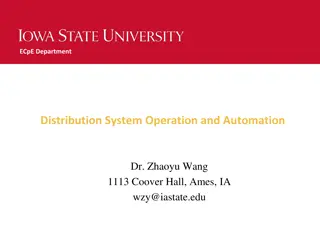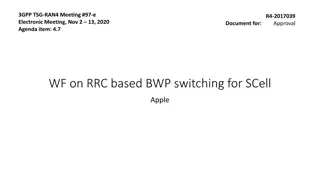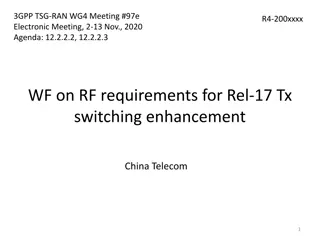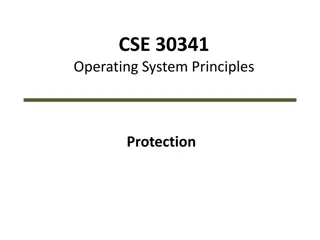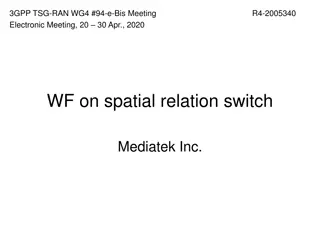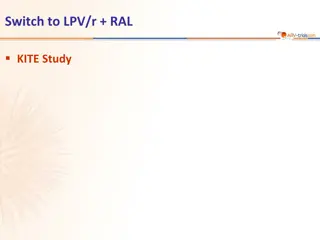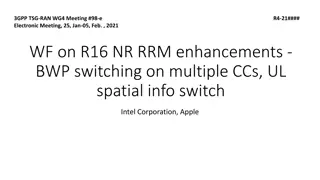
Switching Techniques in Communication Networks
Explore the world of switching techniques in communication networks through circuit switching, packet switching, and message switching. Learn about the key features of a switched communication network and the significance of different types of switching performed by nodes.
Download Presentation

Please find below an Image/Link to download the presentation.
The content on the website is provided AS IS for your information and personal use only. It may not be sold, licensed, or shared on other websites without obtaining consent from the author. If you encounter any issues during the download, it is possible that the publisher has removed the file from their server.
You are allowed to download the files provided on this website for personal or commercial use, subject to the condition that they are used lawfully. All files are the property of their respective owners.
The content on the website is provided AS IS for your information and personal use only. It may not be sold, licensed, or shared on other websites without obtaining consent from the author.
E N D
Presentation Transcript
Switching Techniques Presented by Ms. Bobade Swati Bhaskar Department of Computer Sci. & IT Deogiri College, Aurangabad Maharashtra, 431 005 1
Introduction When there are many devices, it is necessary to develop suitable mechanism for communication between any two devices. One alternative is to establish point-to-point communication between each pair of devices using mesh topology. A better alternative is to use switching techniques leading to switched communication network. In the switched network methodology, the network consists of a set of interconnected nodes, among which information is transmitted from source to destination via different routes, which is controlled by the switching mechanism.
A communication is shown in Fig. 4 The end devices that wish to communicate with each other are called stations. The switching devices are called nodes. Some nodes connect to other nodes and some are to connected to some stations. basic model of a switched
Key features of a switched communication network are given below: Network Topology is not regular. Uses FDM or TDM communication. There exist multiple paths between a source- destination pair for better network reliability. The switching nodes are not concerned with the contents of data. Their purpose is to provide a switching facility that will move data from node to node until they reach the destination. for node-to-node
The switching performed by different nodes can be categorized into the following three types: Circuit Switching Packet Switching Message Switching
Circuit switching Technique Communication via circuit switching implies that there is a dedicated communication path between the two stations. The path is connected through a sequence of links between network nodes. On each physical link, a logical channel is dedicated to the connection. Circuit switching is commonly used technique in telephony, where the caller sends a special message with the address of the callee (i.e. by dialling a number) to state its destination.
It involved the following three distinct steps: Circuit Establishment: -To establish an end-to-end connection before any transfer of data. -Some segments of the circuit may be a dedicated link, while some other segments may be shared. Data transfer: -Transfer data is from the source to the destination. -The data may be analog or digital, depending on the nature of the network. -The connection is generally full-duplex. Circuit disconnect: -Terminate connection at the end of data transfer. -Signals must be propagated to deallocate the dedicated resources. A
Advantages: After path communication without delay. Very suitable for continuous traffic. It establishes a dedicated path. No overhead after call setup. it is transparent and data passes in order. is established, data
Disadvantages: Provide initial delay for setting up the call. Inefficient for bursty traffic. Data rate should be same because of fixed bandwidth. When load increases, some calls may be blocked. In data communication, traffic between terminal and server are not continuous. Sometimes more data may come or sometimes there is no data at all. Circuit switching is not efficient because of its fixed bandwidth.
In circuit switching, network resources are dedicated to a particular connection. Although this satisfies the requirement of voice communication, it suffers from the following two shortcomings for data communication: In a typical user/host data connection, line utilization is very low. Provides facility for data transmission at a constant rate.
Message Switching The problem may be overcome by using an approach known as message switching. Message switching suffers from various problems ,To overcome the limitations of message switching, another switching technique, known as packet switching was invented. In this switching method, a different strategy is used, where instead of establishing a dedicated physical line between the sender and the receiver, the message is sent to the nearest directly connected switching node. This node stores the message, checks for errors, selects the best available route and forwards the message to the next intermediate
The line becomes free again for other messages, while the process is being continued in some other nodes. Due to the mode of action, this method is also known as store-and-forward technology where the message hops from node to node to its final destination. Each node stores the full message, checks for errors and forwards it.
Basic idea: Each network node receives and stores the message Determines the next leg of the route, and Queues the message to go out on that link. Advantages: Line efficiency is greater (sharing of links). Data rate conversion is possible. Even under heavy traffic, packets are accepted, possibly with a greater delay in delivery. Message priorities can be used, to satisfy the requirements, if any. Disadvantages: Message of large size monopolizes the link and storage







